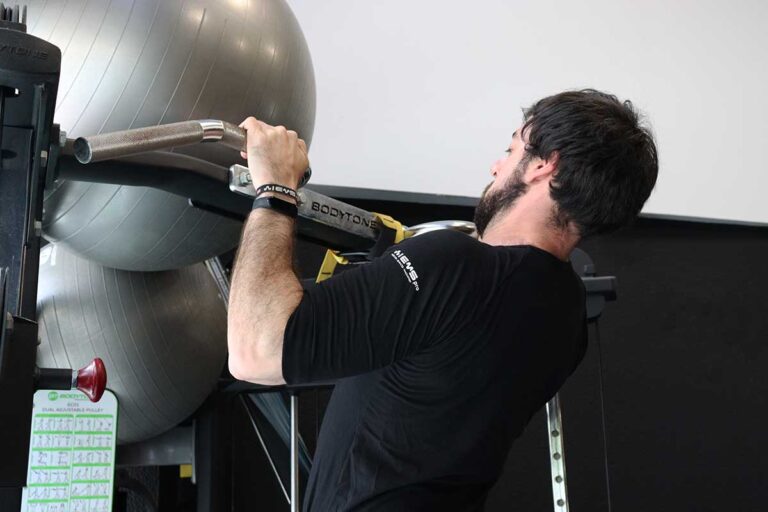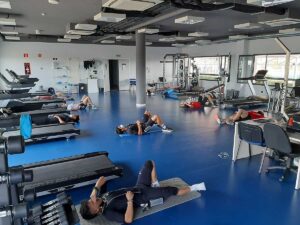Body composition and strength levels are among the most recurring concerns in middle-aged adults. Men and women exercise with the goal of improving their personal and physical image in order to feel better.
However, regardless of this current “concern”, physical exercise is a tool that helps you achieve, not only a better body composition, but also better cardiometabolic health. High strength levels and proper body composition are associated with a lower risk of cardiovascular disease (1, 2).
However, regardless of this current “concern”, physical exercise is a tool that helps you achieve, not only a better body composition, but also better cardiometabolic health. High strength levels and proper body composition are associated with a lower risk of cardiovascular disease (1, 2).
The WB-EMS is capable of stimulating up to 10-12 muscle groups through the placement of a series of electrodes. Thanks to the electrodes, you receive an electrical current capable of producing the impulses necessary to contract the muscles of your body. The electrostimulation vest is used to contract the muscles of the upper and lower body, except for the gastrocnemius muscle due to the discomfort it may cause.
In order to know our participant’s body composition, we ran a dual-energy x-ray absorptiometry (DXA)* and body parameters analysis every two weeks.
* The DXA is a tool that provides data on the levels of bone mineral density (BMD), fat percentage (%), and level of fat-free mass of the body.
Initial assessment
Changes in body composition are not immediate. In fact, it is estimated that at least 2-3 weeks must pass from the start of the intervention to appreciate any changes. However, in order to see whether or not improvement has been made, we must have a baseline on which to build change. In this case, in order to have this baseline, an initial assessment of a specific set of variables was carried out:
- Anthropometry and body composition: Body composition analysis was completed with a DXA, and body parameters were measured.
Training plan
The main goal of this intervention was to reduce fat % and improve body composition in a young adult male. For this purpose, the training plan was based on 3 training days divided into:
- Day of push exercises.
- High intensity interval training day.
- Day of traction exercises.
The training sessions had an average duration of 45 minutes with a warm-up, a main activity, and a final cool-down.
In terms of the organization of the WB-EMS, we use Wiemspro’s own custom frequency, with programs ranging from 7 Hz to 95 Hz. Below, in Image 1, we may see a sample session for Week 4:

Improvements achieved
After measuring the reduction in fat % and assessing the improvement in body composition, we analyze the improvements obtained, as well as other data of interest that we will touch on in the following points.
Bone Mineral Density
For the BMD analysis, we will take into account the initial T-Score and Z-Score levels (two variables that indicate whether you are average, above or below, comparing you with people of the same sex, age, and body composition).
For the BMD analysis, we will take into account the initial T-Score and Z-Score levels (two variables that indicate whether you are average, above or below, comparing you with people of the same sex, age, and body composition).
It is worth noting that the normal values for an individual, regardless of age, are between -1 and 1. Taking this into account, we may say that the participant is a person with good BMD and that, additionally, this has been increased by the exercise with the electrostimulation suit.
Fat mass and anthropometry
The fat % at the beginning of the study was 28.1%, and at the end of the study, it was 21.3%. The reduction was 6.8%.
In turn, waist and hip circumferences at baseline were 103 cm and 111.5 cm, respectively, and lowered to 94.7 cm and 109.5 cm, thus greatly reducing waist circumference and reducing the risk of cardiovascular disease (3, 4).
Based on the initial data, we can say that this person did not present excessively high values of fat mass but, even so, the training managed to reduce the fat percentage, and to approach values related to better health.
Muscle mass
The body composition analysis also provides the values of fat-free mass in the body. In this case, the initial values were 70 kg and increased to 73 kg fat-free mass after the WB-EMS training.
DXA is not the best tool for measuring muscle mass levels, however, the data it provides is very satisfactory for both the trained individual and the utility of the WB-EMS.
At this point, we must stress that it is very difficult to reduce a person’s fat mass while increasing his or her muscle mass. That is why this data may be one of the most important of the entire intervention.
Before and after the body composition program for men
Next, we are going to compare two photographs of the participant’s body both before and after training with full body electrical stimulation.

The decrease in waist circumference and overall body volume is evident.
Another remarkable factor is that the final appearance is not only of a person who is thinner, but also stronger.
The preservation of muscle mass during slimming phases is a process that combines health improvement with current aesthetic trends.
Maintenance and enhancement of muscle mass during fat loss
Thanks to the data previously presented, we can confirm that training with WB-EMS has led to a reduction in fat % while maintaining and even slightly improving muscle mass.
These data are of great importance since, when weight is lost, a large part of it comes from the loss of muscle mass.
It is now thought that a reduction in muscle mass may be associated with a higher likelihood of future sarcopenic obesity.
Therefore, maintaining muscle mass when reducing weight is extremely important.
What does electrical stimulation contribute to this process?
In this sense, it is difficult to isolate the effects of electrical stimulation from the effects of exercise per se.
Moreover, it is worth noting that this training was performed on a person who had previous experience with electrostimulation, so it was not such a novel or unrecognizable stimulus for his body. We already know that the body’s ability to adapt is greater when the stimulus is new and, in this case, even though this individual had a great deal of experience with electrostimulation, it seems that the intervention still had surprising results.
This tells us that if we make progressions of the electrical impulse by combining and changing programs, the person will be able to respond to the electrical stimulus in an optimal way. This way, we will be able to “surprise” the body periodically and create positive adaptations.
On the other hand, the role of the WB-EMS in this case seems to be key to the subject’s adherence, since it provides sensations that are different from conventional training, which may prove to be very motivating and help the person focus the effort on the appropriate body regions at any given moment. Additionally, during HIIT training, it seems that the electrical load superimposed on the exercise helps the user to want to maintain the intensity of the exercise to the very end.
All sessions were monitored with a Polar OH1 heart rate monitor, and we made sure that the training intensities at both cardiovascular and neuromuscular levels were correct.
The WB-EMS has enough safeguards to promote involuntary contraction at the same time as voluntary contraction. This results in an increase in heart rate and energy expenditure during the session, and after some time following the session. Therefore, electrostimulation seems to play a key role in the energy balance during weight and/or fat percentage reduction.
We must remember that for this increase in post-exercise metabolism to have an appreciable effect on fat reduction, nutritional factors and other similar habits must be in line with the goal being pursued.
Conclusion
Full body electrostimulation is a tool that is under continuous debate in terms of the possible advantages or disadvantages it may have.
At Wiems Lab, we want to answer all these questions by analyzing in depth each possible field of application for this tool.
As we have seen, EMS accompanied this man for 6 weeks, and he managed to reduce his weight from 105 kg to 100 kg, while increasing muscle mass and reducing fat %. We have found that his cardiovascular risk values have improved, as well as his strength levels.
We may conclude that the WB-EMS produces the expected results after an exercise intervention and seems to enhance the effects of training, as the numbers achieved in such a short time are highly surprising.
It is worth noting that in this case, there was no reduction in fat-free mass despite the decrease in weight. These results are consistent with some scientific studies that see the WB-EMS as an effective tool to minimize or avoid the loss of muscle mass during weight loss and calorie restriction processes.
Unai Adrian Perez de Arrilucea
Abraham Carlé Calo
Wiems Lab Team
References
2. Miranda VPN, dos Santos Amorim PR, Bastos RR, Canabrava KLR, Júnior MVM, Faria FR, et al. Association of lifestyle and body composition on risk factors of cardiometabolic diseases and biomarkers in female adolescents. Mediators of inflammation. 2020;2020https://pubmed.ncbi.nlm.nih.gov/32694929/.







